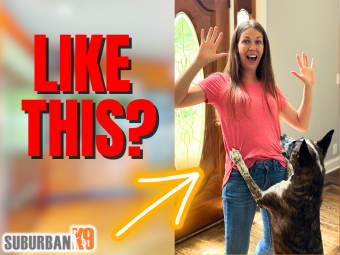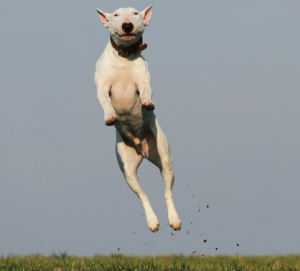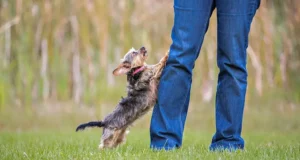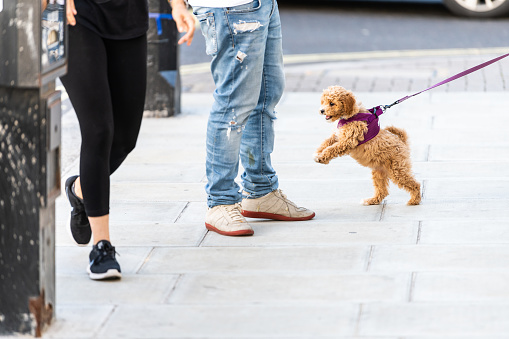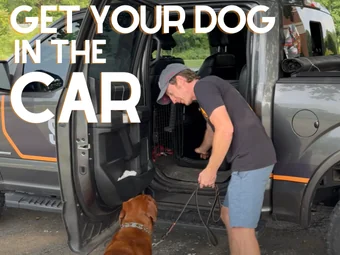When guests arrive at your front door, it's natural for dogs to get excited and express their joy by jumping up to greet them. However, this behavior can be problematic and potentially dangerous. Training your dog not to jump on people at the front door is crucial for a harmonious and safe environment.
Why is it Important to Train my dog not to jump on people?
Safety:
Jumping dogs can inadvertently cause injuries to themselves or others. Small children, elderly individuals, or people with balance issues may be particularly vulnerable to being knocked over or scratched by an exuberant dog. Training your dog to greet guests calmly prevents accidents and promotes a secure environment for everyone.
Respect and Good Manners:
Allowing a dog to jump on people reinforces a lack of boundaries and respect for personal space. Training your dog not to jump teaches them self-control and appropriate behavior. It sets the expectation that polite greetings involve keeping all four paws on the ground, promoting positive and respectful interactions between your dog and guests.
Social Acceptance:
Not all people are comfortable with dogs jumping on them, especially if they have allergies, fear, or simply prefer to keep their clothes clean. By training your dog to refrain from jumping, you create a more pleasant experience for visitors and demonstrate responsible dog ownership.
How do I stop my Dog from Jumping at the Door?
Let's help you learn how to teach your dog to stop jumping and have good manners at the front door! If your dog is too excitable, it can cause a ton of headaches. Using our 3-step front door process will ensure your dog will stop jumping, barking, and nipping at the front door!
Like everything else that we work on, we recommend your dog learn the foundational commands first! This means a strong heel command as well as the rest of their obedience commands. Even though they do not need to be perfect to start this process, the more well-trained your dog is, the easier this process will go!
Get the right tools for training
For this process, we recommend starting with a leash and the appropriate training collar on your dog. The Heel command is the beginning. Heel, for us, means walking in position at our side. We practice a ton of turns to make sure our dogs are focused on us. The main reason we begin here, is because heel calms a dog down as they learn to focus on the handler rather than the external stimuli. A calm dog is a good dog!
Make sure you are not just opening the door and have your dog free. This leads to a ton of issues and an inability to control your dog. We also want to make sure you're not just holding your dog back, as this will never fix this issue.
- Step 1: The first step of our process is calming the dog down before we open the door. This is the most important part of the process! Failure to calm your dog down here will lead to the other two steps being extremely difficult. We want our dogs to be excitable but at a level where they can listen to us. A good benchmark of this is if they can do a left and a right-hand turn. If your dog does not come with you or is racing ahead, give them a tug and get them back to the Heel position!
- Step 2: The second step of this process is when we open the door. Here they get to see the guest for the first time, and it is common for them to be very excited! If your dog gets worked up or they are too excitable, get your dog back into heel until your dog is calm. If they are nice and relaxed, this step is complete!
- Step 3: The last step is a calm meet and greet! If your dog again is too excitable, we will turn away and focus on the dog being calmer. If they can approach calmly, then we are ready for them to greet the guest!
Simple right? The skills required are simple, but you need to take your time with this process. It is common that early on, this will take a few minutes. It is best to take your time and not rush it; otherwise, that will lead to over-correcting your dog. To practice, we recommend using family members or neighbors. Often a dog does not know who is at the door, so having your kids practice ringing the doorbell is a good way to condition them to be calmer. Repetition is key! You can also use significant others! Make sure you are letting your guest know that it will take a few minutes.
This process works well if you practice every day! Now even if you do your best to calm a dog down, there is a chance they can jump on your guests. If they jump, apply our correction process. That is a verbal no and a correction on their leash and collar.
Over time, we will eventually take the leash and collar away, and the length of time it takes to calm down will decrease. In order to get your dog to listen and calm fully off leash and collar, we typically use a short tab.
Conclusion
Training your dog not to jump on people at the front door is a vital aspect of responsible dog ownership. It enhances safety, fosters respect and good manners, and promotes positive social interactions. By implementing consistent training techniques, positive reinforcement, and redirecting energy, you can teach your dog to greet guests calmly with all four paws on the ground. Remember, patience and consistency are key, leading to a well-behaved and well-adjusted dog that greets visitors in a polite and controlled manner. Overall the front door process only uses basic skills, but it takes a ton of practice. With a solid foundation of training and a good front-door training plan, you will impress your guests in no time!
